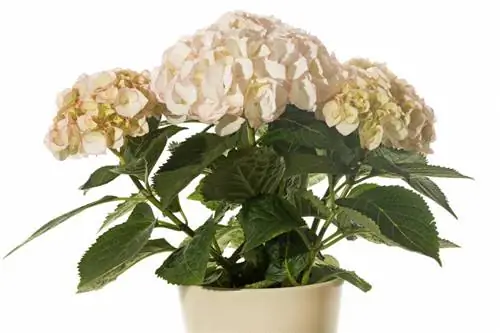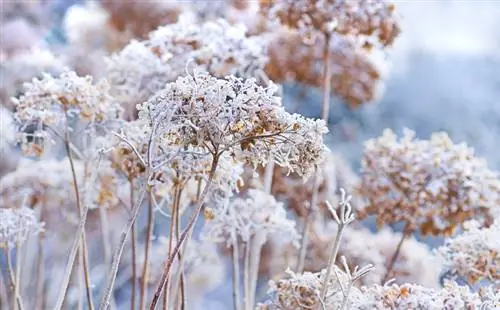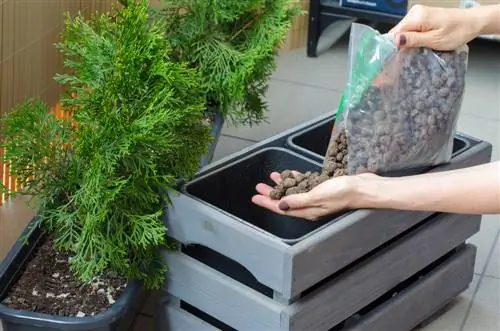- Author admin [email protected].
- Public 2023-12-16 16:46.
- Last modified 2025-01-23 11:20.
In contrast to farmer's and garden hydrangeas, panicle hydrangeas are considered sufficiently hardy to be planted even in harsher climatic regions. In addition, many varieties reach a considerable height and width, although Hydrangea paniculata, as the panicle hydrangea is botanically correctly called, can be easily limited by pruning measures.

How do I care for a panicle hydrangea in a pot?
A panicle hydrangea in a pot requires a 2/3 diameter container, rhododendron soil, regular fertilization and sufficient water. In winter, protect the plant from frost by placing it in a cool, bright place. Varieties that are as compact as possible are ideal for container cultivation.
The right planter and substrate
Bottom hydrangeas need a planter whose diameter is at least two thirds of the diameter of the plant, and you shouldn't skimp on the soil either. Good substrates are characterized by the fact that they are evenly finely crumbled and retain moisture. They contain a sufficiently high proportion of clay minerals and high-quality peat. Rhododendron soil is best.
Fertilize potted hydrangeas regularly
Ready-to-use substrates also contain stored fertilizer and therefore all the nutrients necessary for plant growth. Fertilization is therefore only necessary six to eight weeks after planting. After that, it makes sense to use special liquid fertilizer for ericaceous plants (€20.00 on Amazon). Fertilize your potted panicle hydrangeas about every 8 to 14 days.
Water panicle hydrangea properly in the pot
Since the root space of all plants that grow in boxes, pots and containers is always limited, they must be watered regularly. Otherwise the root balls will dry out quickly. Daily watering, including in the morning and evening in the summer heat, is an absolute must so that your panicle hydrangeas look their best on the balcony and terrace.
Instructions for watering hydrangeas
Check the surface of the substrate before watering. If it is already dry, it is high time to water it. Water generously but slowly - this way the soil cannot be washed out. Excess irrigation water runs out through the drainage holes on the bottom. If you have coasters under the buckets, pour out any water that is left in them. Panicle hydrangeas are very sensitive to waterlogging.
Cutting panicle hydrangea
Pranicle hydrangeas bloom on annual wood and can therefore be cut back heavily in spring, before budding. This actually makes a lot of sense, because cutting stimulates the growth of new shoots and thus the formation of flowers. Even after flowering, the shoots can be cut back a little. Repotting takes place either in spring or after flowering in autumn.
Overwintering panicle hydrangea in a pot
Bottom hydrangeas can be grown outdoors between March and November. Panicle hydrangeas can tolerate a few degrees below zero, but should not be exposed to the cold for long periods of time. The problem with potted plants, even if they are actually hardy, is that the root ball freezes much more quickly than in a bed. Therefore, the plants must overwinter in a frost-free but cool and bright place.
Tips & Tricks
The relatively low dwarf varieties “Bobo” and “Dharuma”, but also larger varieties such as “Phantom” or “Vanille Fraise” are ideal for the pot.






